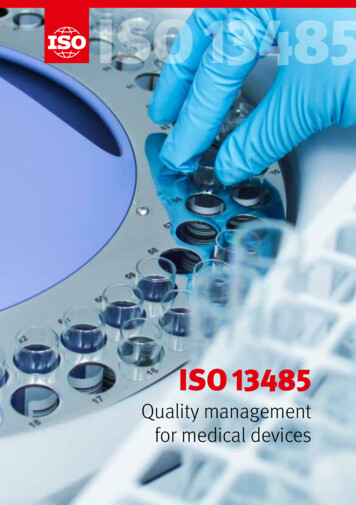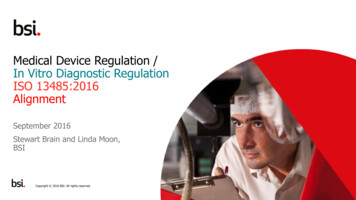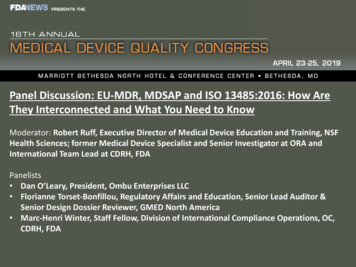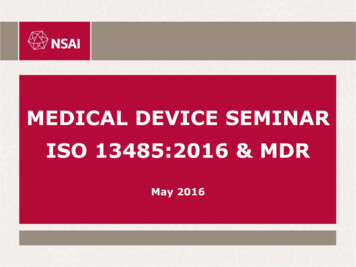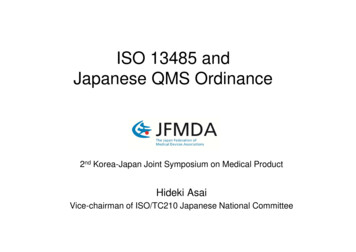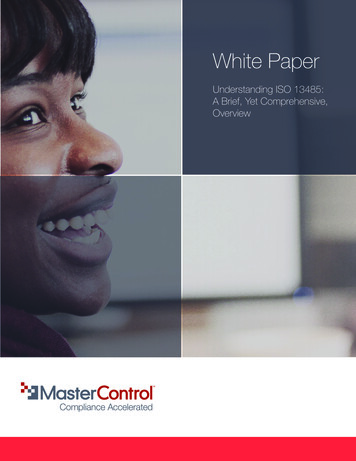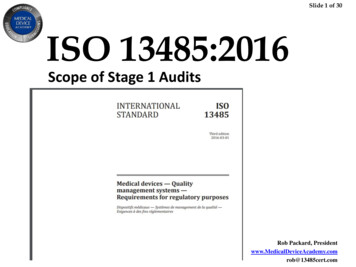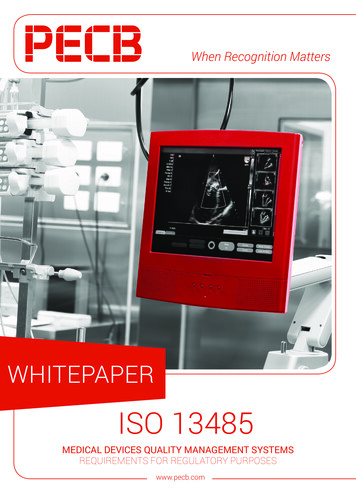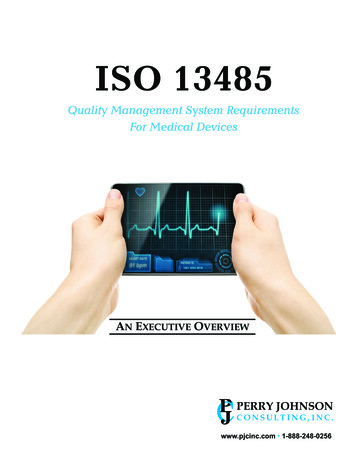
Transcription
ISO 13485Quality Management System RequirementsFor Medical DevicesAN EXECUTIVE OVERVIEWPERRY JOHNSONPCJ C O N S U L T I N G , I N C .www.pjcinc.com 1-888-248-0256
ISO 13485:2016Medical Devices —Quality Management Systems —Requirements for Regulatory PurposesAn Executive OverviewRevised 8/16PERRY JOHNSON CONSULTING, INC.200 East Big Beaver Rd. Troy, Michigan 480831-888-248-0256 or (248) 519-2602Website: www.pjcinc.com Email: pjc@pjcinc.comCopyright 2016 PERRY JOHNSON CONSULTING, INC.All Rights Reserved. No part of this book may be reproduced in any form or byany means without permission in writing from Perry Johnson Consulting, Inc.ISO 13485:2016 Executive OverviewPage 18/16
ISO 13485:2016An Executive OverviewTable of ContentsForeword .3The Users of This Guide .4What is ISO 13485? .5The Origin of ISO the 9000 Series .6Current Good Manufacturing Practices (CGMP) .7CGMP and ISO 13485 Comparison Chart.10Back to ISO 13485 .12Registering to ISO 13485 .16Key Steps to Completing Registration .16What to Look For in a Registrar .17What to Look For in an Auditor .18The Benefits of ISO 13485 .19ISO 13485 Quality Management System Requirements .203 Terms and Definitions.204 Quality Management System .245 Management Responsibility.276 Resource Management .297 Product Realization .308 Measurement, Analysis and Improvement .40Conclusion .45ISO 13485:2016 Executive OverviewPage 28/16
FOREWORDIn 1996, the International Organization for Standardization (ISO) released ISO 13485, Qualitymanagement systems- Medical Devices- Particular Requirements for the Application of ISO 9001 andISO 13488, Quality management systems- Medical Devices- Particular Requirements for the Applicationof ISO 9002. These two international quality management systems standards, medical devices derivativesof ISO 9001, were developed by ISO Technical Committee (TC) 210, Quality Management andCorresponding General Aspects for Medical Devices. U.S. participation in ISO/TC 210 is organized andadministered by the Association for the Advancement of Medical Instrumentation (AAMI).ISO 13485:1996 and ISO 13488:1996 required accountability, compliance with regulations, such as theU.S. Food and Drug Administration (FDA)’s Current Good Manufacturing Practices (CGMP),maintenance of documentation and traceability of products, producing a world-class approach to thedesign, development, manufacture, distribution and servicing of medical devices. Such devices, comingin close contact with patients and ranging from minor support for conditions to life saving capability,demand high criteria.ISO/TC 210, with the participation of the AAMI, revised ISO 13485 and ISO 13488 to align with theprocess-based ISO 9001:2000 and later revision ISO 9001:2008 in 2003.The new version, ISO 13485:2016, Medical Devices – Quality Management Systems – Requirements forRegulatory Purposes, was released in 2016.Registration to ISO 13485, which can aid in complying with regulations, offers a major competitive edgefor medical device companies and is becoming a virtual requirement to do business in manymarketplaces. Far-sighted firms are planning for registration by conducting a thorough investigation ofthe standard s revised requirements.This booklet was created to aid medical device manufacturers seeking to implement ISO 13485:2016, orupgrade from ISO 13485:2003. It outlines the general requirements of ISO 13485:2016.Since registration to ISO 13485 is a lengthy and detailed process, it is strongly suggested that firmsseeking registration retain the services of a reputable consulting firm.PERRY JOHNSON CONSULTING, INC.ISO 13485:2016 Executive OverviewPage 38/16
THE USERS OF THIS GUIDEThis guide will be useful to managers and other personnel in organizations that meet any of the followingcriteria: Medical device designers and manufacturers. Medical device servicing, repair or re-conditioning firms. Manufacturers of custom or implantable medical devices. Manufacturers of accessories used with medical devices. Testing laboratories that work with medical devices. Companies that fabricate medical devices under contract to another firm and subject to itsspecifications. Suppliers seeking to meet customer ISO 13485 registration mandates. Health care industry executives and employees. Agents of foreign medical device manufacturers selling products in the United States, Canada, theEuropean Union and other countries. Medical device manufacturers seeking to meet regulatory ISO 13485 mandates or otherwise complywith government regulations. Government and other regulatory officials. Persons with quality assurance responsibility or interest in a medical device manufacturing setting. Firms wishing to do future business with medical device manufacturers. Consumers interested in production of safe high-quality medical devices. Suppliers seeking a competitive edge in the marketplace. Organizations desiring to make customer satisfaction a top priority. Companies already registered to ISO 13485:2003 seeking an upgrade to ISO 13485:2016. Any other parties with an interest in medical device quality management. Any other firms interested in becoming registered to ISO 13485:2016.ISO 13485:2016 Executive OverviewPage 48/16
WHAT IS ISO 13485?ISO 13485:2016, Medical Devices – Quality Management Systems –Requirements for Regulatory Purposes, is a quality management systemsstandard for the medical devices industry that is derived from ISO9001:2008. This standard was developed by ISO Technical Committee(TC) 210, Quality Management and Corresponding General Aspects forMedical Devices.ISO 13485, released in 2016, is structured similar to the ISO 9001:2008but is written to harmonize with additional medical devices sectorspecific requirements. Many of these sector-specific medical devicerequirements come directly from existing regulations.The medical device field is extensive and rapidly evolving throughtechnological advancements, and demands run high for medical devicesto meet the highest quality levels for health and safety. ISO 13485 is auniversal medical device standard that is applicable to any company inany nation. It provides a roadmap for quality management in medicaldevice manufacturing facilities in order to produce top-caliber products and meet regulatory requirements,such as the U.S. Food and Drug Administration (FDA)’s Current Good Manufacturing Practices (CGMP).Registration provides objective evidence of meeting quality management system requirements of bothcustomers and major regulatory agencies. ISO 13485 registration is objective because a registrar, anindependent certifying body, performs regular audits to verify whether a quality management system ismeeting all requirements. This independent evaluation is important to customers and regulatory agenciesbecause it is an unbiased guarantee that a company is performing at its highest level.Because the ISO 9000 series is the foundation of this standard, one must have a basic knowledge of it inorder to fully understand the fundamentals of ISO 13485. A brief description of this series of standardsfollows.ISO 13485:2016 Executive OverviewPage 58/16
The Origin of ISO the 9000 SeriesISO 9000 is a series of quality management systems standards created by the International Organizationfor Standardization (ISO), a federation of 132 national standards bodies based in Geneva, Switzerland.The American National Standards Institute (ANSI) is the member body representing the United States.The ISO 9000 quality management standards are not specific to products or services, but apply to theprocesses that create them. The standards are generic in nature so that they can be used by manufacturingand service industries all over the world. First released in 1987 and revised in a limited manner in 1994,they underwent a major overhaul in 2000.ISO 9000 is the descendant of a number of earlier quality standards, including the British BS 5750 andDEF/STAN 05-8, the NATO AQAP-1 and the U.S. Department of Defense MIL-Q-9858A. The purposefor developing ISO 9000 was to simplify the international exchange of goods and services by creating acommon set of quality standards.BS 5750 had the greatest influence on this international standard when it was first released by ISO in1987. Most industrialized nations quickly adopted harmonized versions of ISO 9000. These nationalversions, which are identical to the international standard, include the American ANSI/ISO/ASQ Q9000,sponsored by ANSI and the American Society for Quality (ASQ), and the European Union’s EN 29000.ISO 9001:2008 was intended to establish, document and maintain a system for ensuring the output qualityof a process. When implemented correctly, it can offer a company several advantages. It offers a guideto build quality into products or services, and helps to avoid costly inspections, warranty costs andrework.Today, the international standards are sanctioned by the 15 nations of the European Union (EU), makingISO 9001:2008 registration a virtual prerequisite for doing business there. Please note that while ISO13485:2016 is a stand-alone standard, it is structured similar to ISO 9001:2008, which has beensuperseded by ISO 9001:2015. For the convenience of users, Annex B of the standard shows thecorrespondence to ISO 9001:2015.Previously, there were more than 20 ISO 9000 standards and documents, and this proliferation raisedconcerns among ISO 9000 users and consumers. In response, ISO/Technical Committee (TC) 176,Quality Management and Quality Assurance, agreed that the revisions originally issued in the year 2000would consist of four primary standards, supported by several technical reports. These four primarystandards and current revision levels are: ISO 9000:2015, Quality Management Systems – Fundamentals and Vocabulary. This documentsimplifies the quality concepts, terms and definitions that accompany the standard. In addition to arevised vocabulary, this standard includes an introduction to quality-management-principle concepts. For ISO 13485:2016 purposes, ISO 9001:2008, Quality Management Systems – Requirementsspecifies requirements for quality management systems for use where an organization needs todemonstrate its capability to provide products that meet customer and applicable regulatoryrequirements and to enhance customer satisfaction through the effective application of the system,including processes for continual improvement of the system. If an organization can demonstrateconformity to ISO 9001:2008 requirements, it may be registered to this standard.ISO 13485:2016 Executive OverviewPage 68/16
ISO 9004:2009, Quality Management Systems – Managing for the sustained success of anorganization – A quality management approach. a companion to ISO 9001:2008, provides guidanceon quality management systems, including processes for continual improvement that contribute to thesatisfaction of an organization’s customers and other interested parties and processes for selfassessment. Organizations do not and cannot become certified or registered to ISO 9004:2009. ISO 19011:2011, Guidelines for auditing management systems. is an important standard because itaddresses three key areas of concern: internal auditor qualifications, the conduct of internal audits,and internal-audit program management.Current Good Manufacturing Practices (CGMP)Quality management systems for products regulated by the U.S. Food and Drug Administration (FDA),such as medical devices, are known as Current Good Manufacturing Practices (CGMP). Companiesselling medical devices in the United States must meet the applicable CGMP regulation, which iscontained in 21 Code of Federal Regulations (CFR) Parts 808, 812 and 820. Part 820 contains the CGMPquality management system regulation. Part 808 covers exemptions from federal preemption of state andlocal medical device requirements. Part 812 covers investigational device exemptions.CGMP requirements for medical devices were first authorized by Section 520 (f) of the Federal Food,Drug and Cosmetic Act, 21 United States Code 360j (f), which was enacted into law as part of theMedical Device Amendments of 1976. The FDA issued its first CGMP regulation for the manufacture,packaging, storing and installation of medical devices in 1978.A 1990 FDA evaluation of medical device recalls from 1983 to 1989 found that approximately 44 percentwere due to faulty product design. As a result, the Safe Medical Devices Act (SMDA) of 1990 amendedSection 520 (f) to give the FDA authority to add pre-production design controls to the CGMP regulation,and added a new Section 803 that encourages the FDA to work with foreign countries for mutualrecognition of CGMP requirements.Under the SMDA, Section 520 (f) requires manufacturers to have a quality management systemaddressing design, manufacture, packaging, labeling, storage, installation and servicing of medicaldevices for commercial distribution.Section 520 (f) further mandates that specifications and controls be established for each device; devicesare designed under the quality management system so they meet these specifications; devices aremanufactured under the quality management system; devices are correctly installed, checked andserviced; quality data are analyzed to identify and correct quality problems; and complaints are addressedand resolved.The FDA requires producers of finished devices to ensure their parts are acceptable and meetspecifications. Medical device manufacturers covered by CGMP include: Remanufacturers – Firms that renovate or otherwise process a finished device to significantly changeits performance or safety specifications, or intended use. Custom device manufacturers. Contract manufacturers – Companies that fabricate finished devices under contracts with othermanufacturers.ISO 13485:2016 Executive OverviewPage 78/16
Contract testing laboratories – Facilities that design or test components for a manufacturer against itsspecifications is considered an extension of the quality management system. In-house facilities aresubject to CGMP inspections, but not independent laboratories, some of which handle non-medicalproducts. Repackagers, relabelers and specification developers – Firms that alter packaging, distribute domesticor imported devices, or create specifications for devices made by a second party are subject to CGMPrequirements. Packaging, labeling and specifications are considered steps in the manufacturingprocess. Accessory manufacturers – Extra components that are used with main devices, whether supplied to acompany by a contractor or produced in-house, are considered manufacturing steps and are subject toCGMP requirements. Initial distributors of imported devices – Firms or persons that are a foreign company’s point ofcontact with the FDA must maintain complaint files and meet general record keeping requirements.Section 520 (f) also organizes medical devices into classes, based upon their degree of sustaining humanlife, complexity and invasiveness. A Class I device is not intended to be sold or represented as capable of supporting or sustaining life,or preventing an impairment to health, and does not present a risk for illness or injury. It is regulatedby FDA general controls that provide assurance that a product is safe and effective. Class II devices may provide life-sustaining abilities. These devices must be produced underperformance standards that ensure they will be safe and effective during operation, with the FDAinspecting and approving the control methods the manufacturer chooses to make certain the devicesare safe and effective. Special controls, such as performance and design standards, post-marketmonitoring and patient registries, are also recommended. A Class III device is often life sustaining or may help prevent impairment to human health. Generalor special controls are insufficient to ensure their safety and effectiveness. Some Class III devicesmust receive a pre-market approval (PMA) or undergo a product development protocol (PDP) by theFDA before being sold.Following SMDA approval, the FDA began the CGMP revision process to add design controls and makethe regulations consistent with international quality management system requirements. In 1993, the FDApublished a CGMP revision proposal. FDA representatives worked with ISO/TC 210 and the GlobalHarmonization Task Force (GHTF), which consists of government and medical device industryrepresentatives from the U.S., Canada, the European Union (EU), Japan and Australia, to harmonizeproposed CGMP revisions with ISO 9001:1994, ISO 13485:1996, the European medical device qualitystandard EN 46001:1996, and the EU Medical Devices Directive.The FDA issued a Working Draft of the revised CGMP in 1995 and published the revised CGMPregulation in 1996. This regulation took effect in 1997, except for the design control requirements, whichbecame effective in 1998.ISO 13485:2016 Executive OverviewPage 88/16
CGMP requirements now cover a full quality management system, including designing, manufacturing,packaging, labeling, storing, installing, purchasing and servicing medical devices intended for human use.Medical device producers located or doing business in the U.S. must meet CGMP requirements as part oftheir commitment to comply with all regulations under ISO 13485 and assure that their medical devicesare safe and effective for the intended use.Component manufacturers are exempt from the CGMP regulation. A component is defined by Section820.3 (c) as “any raw material, substance, piece, part, software, firmware, labeling or assembly which isintended to be included as part of the finished, packaged and labeled device.”Manufacturers must establish quality management systems appropriate to the devices designed andmanufactured, and the manufacturing processes employed. They must adopt current and effectivemethods and procedures for each device they design and manufacture to comply with and implementCGMP requirements.CGMP requirements in Part 820 were drafted to harmonize with ISO 9001:1994 and ISO 13485:1996,and use a similar structure.These requirements provide a general blueprint for any medical device manufacturer, whether they makesimple surgical hand tools or massive magnetic resonance imaging (MRI) machines. General objectivesare listed, such as properly trained employees, design reviews and validation, calibrated equipment andprocess controls, instead of specific methods. CGMP requirements are flexible, allowing manufacturersto select their own methods for compliance.CGMP is organized into the following subparts. Section titles appear in the comparison chart on the nexttwo pages.Subpart AGeneral Provisions (Sections 820.1, 820.3 and 820.5)Subpart BSubpart CQuality management system Requirements (Sections 820.20, 820.22 and 820.25)Design Controls (Section 820.30)Subpart DDocument Controls (Section 820.40)Subpart EPurchasing Controls (Section 820.50)Subpart FSubpart GIdentification and Traceability (Sections 820.60 and 820.65)Production and Process Controls (Sections 820.70, 820.72 and 820.75)Subpart HAcceptance Activities (Sections 820.80 and 820.86)Subpart INonconforming Product (Section 820.90)Subpart JSubpart KCorrective and Preventive Action (Section 820.100)Labeling and Packaging Control (Sections 820.120 and 820.130)Subpart LHandling, Storage, Distribution and Installation (Sections 820.140, 820.150, 820.160 and820.170)Subpart MRecords (Sections 820.180, 820.181, 820.184, 820.186 and 820.198)Subpart NServicing (Section 820.200)Subpart OStatistical Techniques (Section 820.250)ISO 13485:2016 Executive OverviewPage 98/16
CGMP and ISO 13485 Comparison ChartCGMPISO 13485:2016820.1Scope1Scope820.3Definitions3Terms and Definitions820.5Quality management system4.1.1-4.1.64.2.14.2.2General RequirementsDocumentation-GeneralQuality Manual820.20Management Responsibility5.15.35.45.55.6Management CommitmentQuality PolicyPlanningResponsibility, Authority andCommunicationManagement Review820.22Quality Audit8.2.4Internal Audit820.25Personnel6.2Human Resources820.30Design Controls7.3Design and Development820.40Document Controls4.2.4Control of Documents820.50Purchasing 0Production and Process Controls7.5.1Control of Production andService Provision820.72Inspection, Measuring and TestEquipment7.6Control of Monitoring andMeasuring Devices820.75Process Validation7.5.6Validation of Processes forProduction and ServiceProvision820.80Receiving,7.4.3In-Process and Finished DeviceAcceptance8.2.6Verification of purchasedproductMonitoring and Measurement ofProduct820.86Acceptance Status7.5.8Status Identification820.90Nonconforming Product8.3Control of NonconformingProduct820.100Corrective and PreventiveAction8.5.28.5.3Corrective ActionPreventive Action820.120Device Labeling7.5.1Control of Production andService ProvisionISO 13485:2016 Executive OverviewPage 108/16
CGMPISO 13485:2016820.130Device Packaging7.5.11Preservation of Product820.140Handling7.5.11Preservation of Product820.150Storage7.5.11Preservation of Product820.160Distribution7.5.11Preservation of Product820.170Installation7.5.3Installation Activities820.180General Requirements (Records)4.2.5Control of Records820.181Device Master Record4.2.3Medical Device File820.184Device History Record4.2.5Control of Records820.186Quality management systemRecord4.2.5Control of Records820.198Complaint Servicing Activities820.250Statistical Techniques8.4Analysis of DataISO 13485:2016 Executive OverviewPage 118/16
Back to ISO 13485In highly industrialized countries, medical devices have long been subject to government regulation, withthe U.S. market under the jurisdiction of the FDA. As these regulations evolved, many of them haveincorporated quality management system requirements for medical device manufacturers, such as theFDA’s CGMP and the Japanese Good Manufacturing Practices Regulation.Following the development of the ISO 9000 Quality Management Systems (QMS) standards, issued in1987, an international demand arose to apply ISO 9000 quality management systems to medical devices.The Global Harmonization Task Force (GHTF), whichconsists of government and medical device industryrepresentatives from the U.S., Canada, the European Union(EU), Japan and Australia, was established in 1992 with thegoal of harmonizing medical device regulations. TheGHTF seeks to produce globally harmonized guidancedocuments that address regulation of medical device safety,performance and effectiveness; promotion of technicalinnovation; and encouragement of global trade. Its StudyGroup 3 has worked to harmonize regulatory QMSrequirements in the world’s major markets.Meanwhile, the EU developed its own medical device derivatives of the 1987 ISO 9000 standards,releasing in 1993 European Normative (EN) 46001:1993, a harmonized version of ISO 9001:1987, withspecific requirements for suppliers of medical devices, along with EN 46002:1993, a medical devicesderivative of ISO 9002:1987. EN 46002 differed from EN 46001 by excluding the design control element(4.4). Due to the importance of the European market, EN 46001 and EN 46002 were adopted andimplemented by medical device manufacturers around the world.At the same time, medical devices sold in the EU must meet health and safety product requirements in theNew Approach Directives, thereby acquiring CE Marking, a necessity for their sale in Europe. The ENstandards and their successors are applied to the conformity assessment requirements of these directives,with manufacturers required to register to these standards. The three directives that apply to medicaldevices are the Active Implantable Medical Devices Directive (AIMD), approved in 1993 and fullyeffective in 1994; the Medical Devices Directive (MDD), approved in 1995 and fully effective in 1998;and the In Vitro Diagnostic Medical Devices Directive, approved in 1999 and fully effective in 2003.In 1993, the GHTF advocated harmonization of medical device regulations with ISO 9000. The ISOTechnical Management Board (TMB) responded by recognizing that the medical device sector, due to itsheavy worldwide regulation, requires sector-specific standards. As a result, in 1994 it approved thecreation of Technical Committee (TC) 210, Quality Management and Corresponding General Aspects forMedical Devices, to manage development of quality management system and risk management standardsin order to effectively address the needs of regulatory authorities and manufacturers, protect health andsafety, eliminate trade barriers and promote global harmonization.ISO 13485:2016 Executive OverviewPage 128/16
ISO/TC 210 established a Memorandum of Understanding (MOU) with the GHTF. The Association forthe Advancement of Medical Instrumentation (AAMI) was chosen by ANSI to administer the Secretariatand U.S. Technical Advisory Group (TAG) of ISO/TC 210. AAMI, founded in 1967, is an alliance ofnearly 6,000 users and manufacturers of medical instrumentation and technology, and the leadingdeveloper of national and international standards for the manufacture, use and maintenance of medicaldevices. It is the primary source of consensus and timely information on medical instrumentation andtechnology.Following the release of revised ISO 9000 standards in 1994, ISO/TC 210 began the process ofdeveloping medical device derivatives. In 1996, it released ISO 13485:1996, Quality managementsystems - Medical Devices - Particular requirements for the application of ISO 9001, a harmonizedversion of ISO 9001:1994, with specific requirements for suppliers of medical devices, along with ISO13488:1996, Quality management systems - Medical Devices - Particular requirements for theapplication of ISO 9002, the medical devices derivative of ISO 9002:1994. As with the EN standards,ISO 13488 differed from ISO 13485 by excluding the design control element (4.4).The EU continued to go its own way with ISO 9000 medical device derivatives, revising the ENstandards to align with the 1994 ISO 9000 standards. In the same year, it released EN 46001:1996,Quality management systems - Medical devices – Particular requirements for the application of EN ISO9001, and EN 46002:1996, Quality management systems - Medical devices – Particular requirements forthe application of EN ISO 9002. The revised EN standards had slightly different sector-specificrequirements from those of ISO 13485 and ISO 13488.Other documents developed by ISO/TC 210 have been ISO 14969:1999, Quality management systems –Medical Devices – Guidance on the Application of ISO 13485 and ISO 13488, and ISO 14971:2000,Medical Devices – Application of Risk Management to Medical Devices.In 1998, Health Canada became the first regulatory body to require medical device manufacturers toachieve ISO 13485 or ISO 13488 registration in order to obtain device licenses to sell their products.Section 32 of Canada’s Medical Device Regulations created the Canadian Medical Device ConformityAssessment System (CMDCAS) to administer the registration system, with registration required by 2003.The importance of ISO 13485 in encouraging and supporting global harmonization of medical devicerequirements increased in 1999, when the GHTF held extensive discussion about completely phasing outthe EN 46000 series in favor of ISO 13485 and ISO 13488. In 2000, ISO 13485 and ISO 13488 becameEuropean standards, replacing EN 46001 and EN 46002. Later that year, the ISO 9000 standards wereagain revised, with ISO 9001 the sole registration standard.ISO/TC 210 then began the process of revising ISO 13485 and ISO 13488 to align with ISO 9001.Despite ISO 9001:2000 Section 1.2, Application, which allows the exclusion of design controlrequirements (now Element 7.3), thereby eliminating the need for ISO 13488, ISO/TC 210 initiallydecided to revise both standards, producing Committee Draft (CD) versions of these revisions in 2001.ISO/CD 13488:200x, Qu
13485:2016 is a stand-alone standard, it is structured similar to ISO 9001:2008, which has been superseded by ISO 9001:2015. For the convenience of users, Annex B of the standard shows the correspondence to ISO 9001:2015. Previously, there were more than 20 ISO 9000 s
